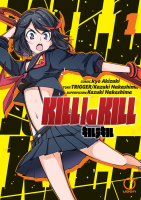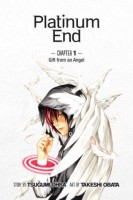File this column under I’m Not Dead Yet! November has been hectic, and it shows; my last post was over a month ago. Today’s column is an attempt to get back on track with regular updates. On the agenda are reviews of Kill la Kill, an adaptation of the wildly popular anime, and Platinum End, a new shonen series with an impeccable pedigree.
 Kill la Kill, Vol. 1
Kill la Kill, Vol. 1
Comic by Ryo Akizuki; Story by TRIGGER and Kazuki Nakashima
No rating (best for readers 13+)
UDON Entertainment, $12.99
In my small and unscientific sampling of manga based on anime, I’ve read a lot of duds. Wolf’s Rain and Cowboy Bebop, for example, both fell flat in print, conveying little of the personalities or plot intricacies that made both animated series compelling. Kill la Kill is a more artful transfer of show to page, but suffers from some of the same issues as other anime-cum-manga.
Like the anime on which it’s based, the Kill la Kill manga see-saws between flamboyant parody and straight-faced action, mixing jokey conversations with bone-crunching fights. Navigating these tonal extremes in print proves challenging, however. The manga is funniest when skewering tropes that don’t need sound effects or color to make the joke stick–like equipping characters with goofy weapons or populating Honnouji Academy with students who look like extras from Mad Max: Beyond Thunderdome.
The artists’ desire to spoof other cliches fall flat. On the page, heroine Ryuko Matoi’s barely-there power suit seems like blatant pandering to the male gaze; the artistic team lavishes considerable attention on Ryuko’s body, lovingly depicting her torso and buttocks from myriad angles. On the screen, however, the addition of sound puts a different spin on the material. The cheerful voice acting, peppy music, and snappy sound effects transform an exploitative sequence into an absurd riff on the indignities of fighting in a costume that consists of two well-placed suspenders and a dinner napkin. It isn’t deep, but it is funny, highlighting the stupidity of the “power up!” sequence that’s ubiquitous in anime, manga, and tokusatsu.
The manga suffers from the absence of color and sound in other passages, too. Without a voice actor to modulate the dialogue, almost EVERY PAGE READS LIKE THIS!!! OMG!!! ARE YOU LAUGHING YET??!!!! By the end of volume one, I felt pummeled into submission rather than amused by the affectionate send-up of Japanese pop culture’s most ubiquitous storytelling conventions.
The verdict: The manga looks like a million bucks, but the script strains too hard for effect.
 Platinum End, Chapter 1
Platinum End, Chapter 1
Story by Tsugumi Ohba, Art by Takeshi Obata
Rated T+, for teens over 13
VIZ Manga, $.99 (digital only)
Over the last twelve months, VIZ has been experimenting with digital-first releases, a strategy that’s worked well for high-profile shonen titles like One-Punch Man and Tokyo Ghoul. It’s not surprising, then, that VIZ is using the same roll-out for Platinum End, the latest collaboration between Death Note creators Tsugumi Ohba and Takeshi Obata. This time, however, VIZ is making the first chapter of the series available as a stand-alone option–a decision that may backfire if other readers find it as off-putting as I did.
The main issue is the story. It’s mawkish and violent, shamelessly manipulating the reader into feeling sorry for a sullen protagonist by mining familiar adolescent themes: “I was born into the wrong family!” “No one will miss me when I’m gone!” “They’ll be sorry when I’m powerful/rich/famous!” We’re first introduced to Mirai as he’s leaping to his death. As we learn through flashbacks, he was orphaned at eight, and forced to live with an aunt and uncle who treated him like a slave. Nasse, a guardian angel, foils Mirai’s suicide attempt and grants him superpowers that are supposed to make him happy.
Lest you worry that Ohba and Obata have lost their taste for violence, Mirai’s first road test of these newfound abilities results in a gruesome, sexually charged scene. Ohba and Obata have stacked the deck firmly against the victims, but the characters are so cartoonishly evil (and visually repulsive) that their punishment registers not as a justifiable act of vigilantism, but as a plot contrivance. Ohba takes other narrative shortcuts in these opening pages, saddling guardian angel Nasse with dialogue that baldly explains her reasons for helping Mirai–an amateurish and lazy way to justify her part in the drama.
Perhaps the most disappointing element of Platinum End is Obata’s artwork. Though the human characters are drawn with consummate attention to detail, Mirai’s angelic sidekick is utterly generic: she’s a wide-eyed cutie with wings, ringlets, and halo. When placed side by side with Obata’s greatest supernatural creations–Death Note‘s Ryuk and Rem–the paucity of imagination is startling. Obata’s shinigamis looked like otherworldly rock stars with their glassy eyes, Frankenstein scars, and feathery protrusions, whereas Nasse looks like something traced from How to Draw Manga (or perhaps a volume of Kobato). That’s a pity, because Obata’s artwork has carried me through rough patches in his other series; here, however, it doesn’t really do much other than emphasize how thin the story is.
The verdict: Platinum End may find its footing in later chapters, but the first 70 pages are such a let-down that I won’t be tuning in for later installments.
Reviews: At Adventures in Poor Taste, Jordan Richards posts a more positive assessment of Platinum End (though he shares some of my reservations about the lead female character). Also weighing in on the first chapter of Platinum End is Justin Stroman, who offers an in-depth, spoiler-heavy review at Organization Anti-Social Geniuses. Foodies may prefer to visit The Manga Test Drive, where Megan R. samples two culinary comics: Mixed Vegetables, a shojo rom-com about rival teen chefs, and Not Love But Delicious Foods Make Me So Happy!, an older Fumi Yoshinaga title.
Mark Pellegrini on vol. 2 of AKIRA (AiPT!)
Connie on Alice in the Country of Clover: Lizard Aide (Slightly Biased Manga)
Helen on The Ancient Magus’ Bride (Organization Anti-Social Geniuses)
Lori Henderson on Awkward (Manga Xanadu)
ebooksgirl on vol. 12 of Chi’s Sweet Home (Geek Lit Etc.)
Connie on vol. 2 of Citrus (Slightly Biased Manga)
Theron Martin on vol. 27 of Claymore (Anime News Network)
Chris Sims on COWA! (Comics Alliance)
Connie on vol. 13 of Dorohedoro (Slightly Biased Manga)
Terry Hong on Fragments of Horror (Book Dragon)
Jordan Richards on vol. 1 of JoJo’s Bizarre Adventure Part 2: Battle Tendency (AiPT!)
Christophe on Junji Ito’s Cat Diary: Yon & Mu (Anime UK News)
Ken H. on vol. 1 of Kiss Him, Not Me! (Sequential Ink)
Demeiza on vol. 1 of Livingstone (Anime UK News)
Johanna Draper Carlson on vol. 4 of Love Stage!! (Comics Worth Reading)
Wolfen Moondaughter on vols. 3-4 of Maid-Sama! (Sequential Tart)
Rebecca Silverman on vol. 1 of Monthly Girls’ Nozaki-Kun (Anime News Network)
Kane Bugeja on vols. 1-2 of One-Punch Man (Snap 30)
Al Sparrow on vol. 1 of Pandora in the Crimson Shell: Ghost Urn (Comic Spectrum)
Sean Gaffney on vols. 21-22 of Ranma 1/2 (A Case Suitable for Treatment)
Kristin on vol. 2 of Requiem of the Rose King (Comic Attack)
Alice Vernon on vol. 1 of Rose Guns Days: Season One (Girls Like Comics)
Sarah on vol. 3 of Servamp (Anime UK News)
Robert Prentice on vol. 8 of Food Wars! Shogugeki no Soma (Three If By Space)
ebooksgirl on vol. 1 of School Live! (Geek Lit Etc.)
Nick Creamer on vol. 3 of A Silent Voice (Anime News Network)
Danica Davidson on vol. 1 of So, I Can’t Play H (Otaku USA)
Jordan Richards on vol. 1 of UQ Holder (AiPT!)
Austin Lanari on issue 51 of Weekly Shonen Jump (Comic Bastards)
Ash Brown on vol. 8 of What Did You Eat Yesterday? (Experiments in Manga)
Wolfen Moondaughter on vol. 4 of Yukarism (Sequential Tart)